Alocasia dragon scale has deeply textured leaves with Dragon Scale like markings. It definitely has a dramatic and prehistoric look.
Read our Alocasia Dragon Scale Care guide at the bottom of this post to learn all about how to care for this Alocasia plant.
The Dragon Scale, like other Alocasias is considered somewhat rare and a bit difficult to source.
You’ll find The Dragon scale is sporadically available in your local plant shop or nurseries. But beware, If you do find an alocasia marked as a Dragon scale… make sure it is properly named.
This plant is fairly easily confused with the Alocasia Polly, Alocasia Regal shield and Alocasia Black Velvet. Even the bambino when they are small. Know what to look for…
Watch for the characteristic Deeply textured leaves and Dark veining. The dragon scale has light green color on the underside of the leaves. The dragon has a simple leaf shape and leaf edge. Rather than the more jagged edged leaves of the Polly.
There are many varieties with similarities in these smaller jewel Alocasia. They are easy to confuse. Especially when young.
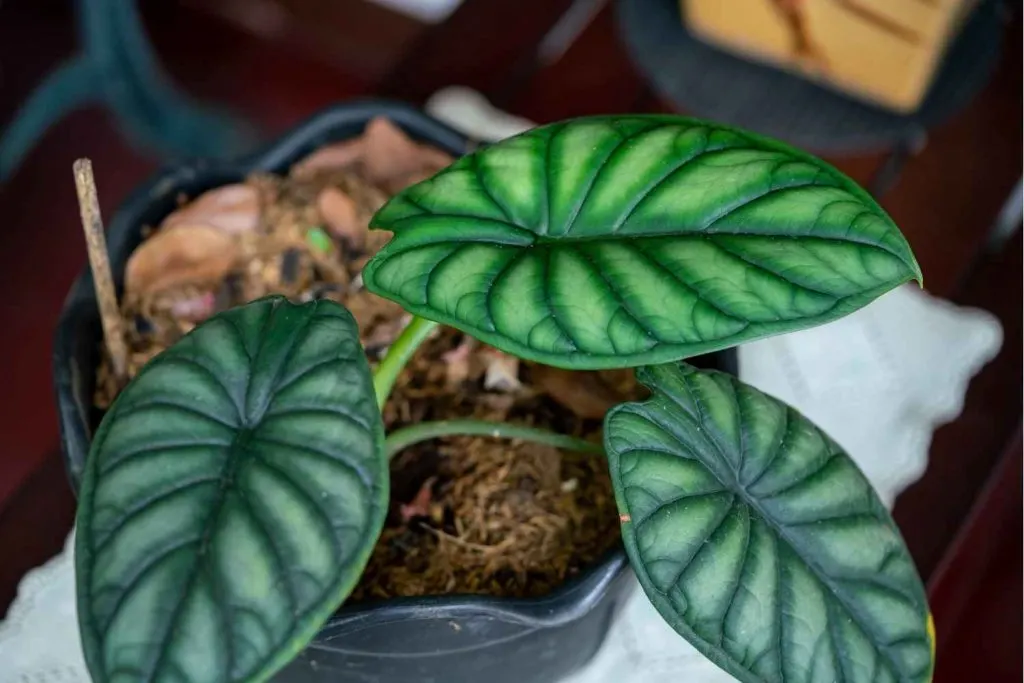
The most common Dragon scale is the dark green leafed variety. However there is a Sliver Dragon color variety as well.
Alocasia Dragon Scale Plant Profile:
Alocasia has almost a hundred different species. They come in many different forms. You’ll find new and interesting varieties available as time goes along. The alocaisas are getting more available.
These plants were originally collected from the tropical jungles of Borneo, Southeast Asia and certain places in Australia. However, several cultivated varieties and hybrids are now available.
All alocasia plants are from the plant family Araceae. Like all aroids, Alocasias enjoy light well draining soil so their roots have excellent aeration.
The dragon scale can grow up to 36 inches high and around 18 inches wide. This size is perfect for a houseplant.
Place your Dragon Scale on a table top or a well lit plant shelf. It will also do well on the floor if you have a nook with bright indirect light away from drafts and vents.
However, Beware of this toxic plant. It can harm pets and children if chewed. Read our Toxic plant warning below.
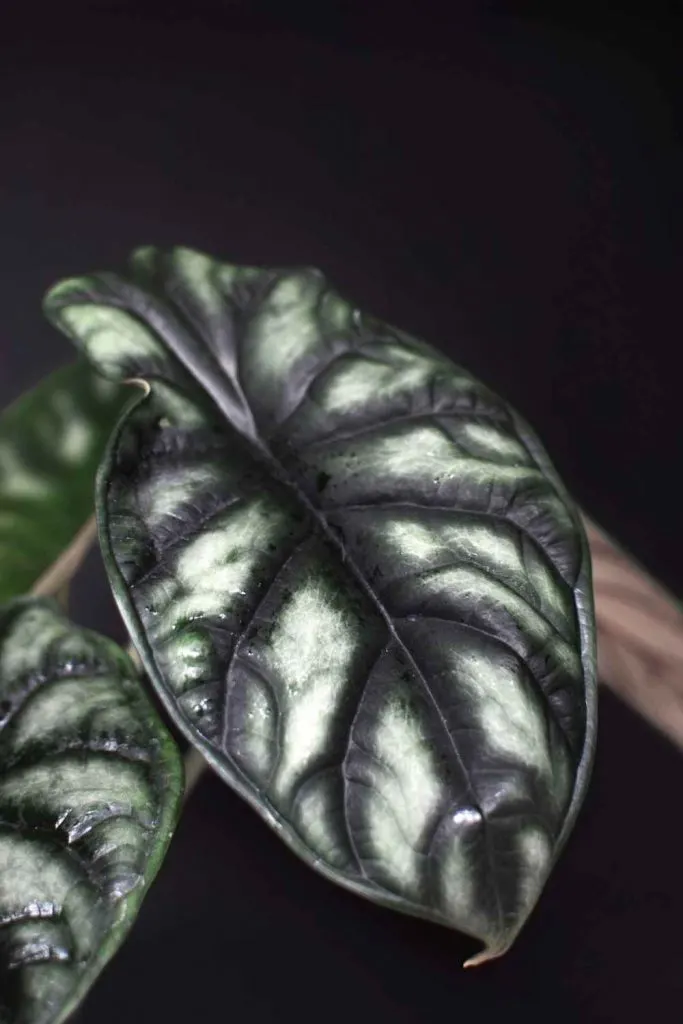
Alocasia Silver Dragon:
This plant has two common colors. The Silver Dragon is a beautiful color form of the Alocasia Baginda. Its care needs are the same as the darker Dragon Scale plants.
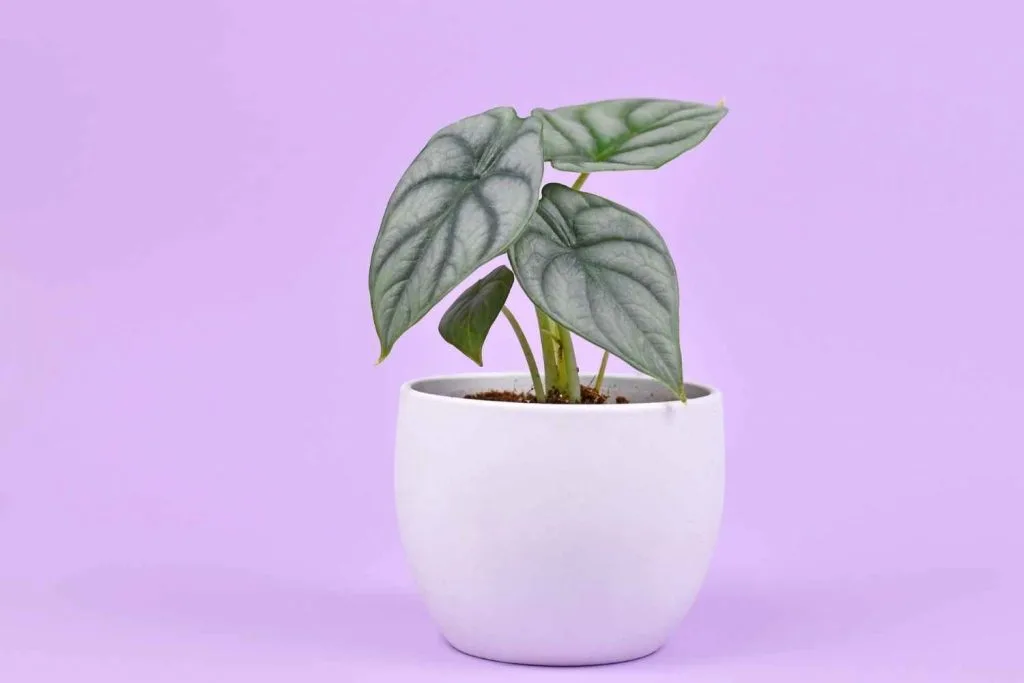
These are interesting and beautiful plants. Both of the color varieties of the Dragon Scale will do well in your home and naturally filter the air of certain toxic chemicals. They just need the correct conditions to thrive.
You’ll likely find a beautiful alocasia for your home if you look around locally. But the Dragon scale varieties are a bit more difficult to source at the moment in local shops.
If you can’t find a dragon scale locally there are several shops on Etsy that will send you one.
The Alocasia Dragon Scales are moderately priced at under $50 for a 4 inch plant for most shops I’ve seen.
Etsy is probably your best, most reliable source for the Alocasia Baginda Dragon Scale or the Silver Dragon. Look for a shop with good ratings and a lot of them.
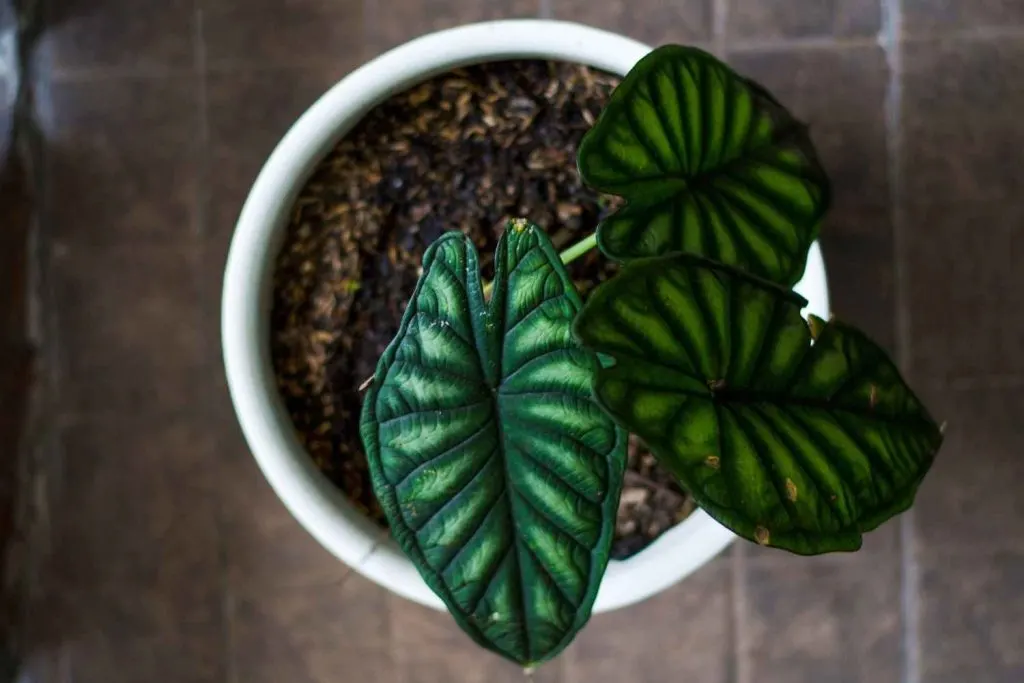
Alocasia Baginda Dragon scale is a dark beautiful plant with arresting light green highlights that draw the eye. Set this plant in the proper place to add interest.
It will definitely liven up a bright area of your home.
Toxic Plant Warning:
Like the Pothos plants, and most other aroids, the alocasias are toxic to pets and people in varying degrees. They contain Calcium Oxalate crystals which are moderately toxic when the leaf and stem or rhizome of the plant are chewed.
This will cause irritation the mouth and some swelling. Although not usually lethal Keep this plant away from small children and pets.
Read our Post on Pet Safe Non Toxic Plants For ideas on safe plants for your Home
How do you take care of Alocasia Dragon Scale?
All the alocasias are similar in their care needs. Which is great if you want to build an alocasia collection.
Read our care guide below to discover all the tips and important information for caring for these tropical aroid beauties.
Alocasia Dragon Scale Care
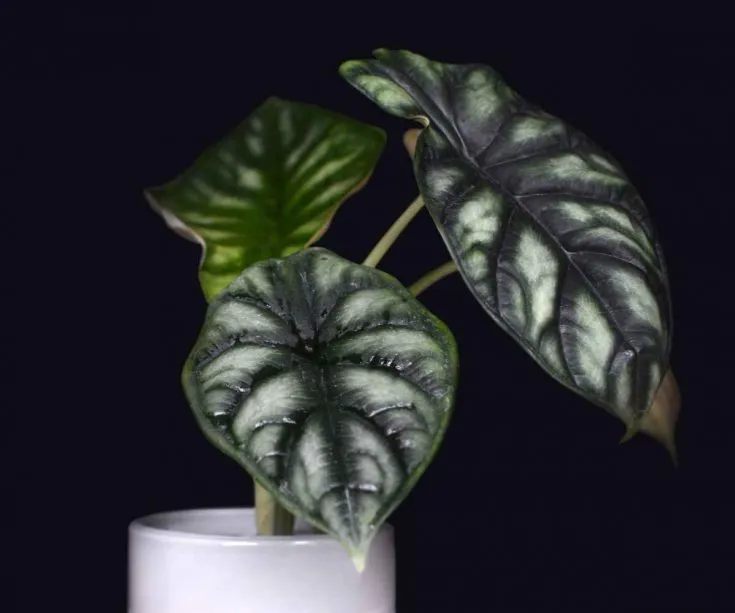
Alocasia Dragon Scale plants have bold heart shaped velvety textured leaves. The dark leaf color contrasts sharply with the dramatic white viens and purple leaf underside.
This is a small alocasia susceptible to root rot. Pay particular attention to the watering needs of this plant.
Tools
Instructions
Soil Preference:
- This plant requires a light well draining soil mix. Alocasias and other aroids cannot have water compact around the roots.
- A mix of potting soil, succulent soil mix and orchid soil mix (look for one with a lot of peat and finer bark mix) will keep the roots happiest.
- Two parts potting soil to two parts succulent mix to two parts orchid bark.
- A heavy soil potting mix is not recommended for this plant.
- Due to this alocasias senstivity to over watering LECA growing is recommended. See our LECA Post series here.
Pot Size and Type:
- This plant needs a pot only an inch or two above the previous pot size. Chooosing too large a pot can encourage root rot.
- Porous pots will work well for this alocasia. Terra cotta wicks away excess water from the soil. These plants enjoy a pot that breathes and keeps their feet dry.
- Repot every second year or when roots come out the drainage holes on the pot bottom.
Lighting:
- Alocasia Dragon Scale requires strong indirect light.
- Shield this plant from strong direct light in summer south and west sunny windows. The leaves will burn.
- Tips: Window sheers or blinds can offset some brief periods of high direct light.
- In darker winter months the plant will most likely go dormant. If it appears to need more light you may find an indoor grow light helpful in darker climates.
Watering:
These Jewel Alocasias are VERY easy to overwater.
- Try a watering schedule of every week. Water thoroughly until the water runs out of the pot.
- Watering is best done on a regular schedule so the plant is not over or under watered. Both can cause stress on the plant.
- Never let this plant get wet feet. Alocasias need to dry out between waterings. But the roots need hydrating. for this reason I use a moisture meter and water whne the root zone is almost or lightly in the dry zone.
- They cannot tolerate heavy compacted wet soil. If the soil is compacted the bottom of the soil can remain wet which encourages root rot and fungus gnats.
- Alocasia Plants are aroids. They have roots which need a lot of oxygen and will tolerate drier conditions that larger alocasias.
- These plants are good candiates for growing in semihydroponics like LECA.
Humidity:
- Alocasias need humidity or 40 to 60% or more to be happy.
- TIPS: Set the container on a pebble tray with water under the pot or provide a humidifier to this tropical plant for best growth and happiness.
- Make sure you are not keeping your plant next to a heat or air vent. This will dramatically lower the humidity level.
- humidity also improves when you group plants together more closely.
- If the leaf tips go yellow or the leaves curl under on the edges. suspect humidity is too low.
How to Fertilize:
- Alocasias require regular fertilizing.
- Apply a good quality fertilizer (linked in materials) monthly through Spring and summer.
- Alternately you can use a slow release fertilizer at the beginning of the growing season.
- Decrease feedings by late Fall and allow the plant to rest through the winter months.
Temperature:
- Keep this plant at a low of 60 Degrees F. to upward of 85 Degrees F. It enjoys warmth and humidity.
Pests:
- Alocasias can be attacked by pests.
- Stress by longterm overwatering, poor light, extreme temperatures and soil conditions are contributors to plant stress..
- Spider mites, mealy bugs, scale, thrips and whitefly are the most common houseplant pests you will see.
- Read our post on How to get rid of aphids and other pests with our homemade pesticide soap recipe or neems oil.
- To minimize the possibility of pests be sure to check all nursery plants before bringing them home.
- Quarantine all new plants until you are sure no pests live in them.
How to Propagate:
- This plant is easily propagated through rhizome division.
- Start with a healthy and mature Alocasia plant
- Divide the rhizomes when repotting the plant
- Plant new rhizome start into a pot with similar soil mix to the mother plant.
- Keep the soil moist while the new plant acclimates and matures
Toxicity:
1. This plant is considered toxic. Do not ingest any part of the plant. This plant can also cause mild skin irritation. Keep away from children and pets.
Notes
The video bleow applies to most Alocasias. For all alocasia plants remember they need to dry SLIGHTLY between waterings and grow in small pots for the rhizome size to allow the roots to get the oxygen they need.
Follow Us:
Find us on YouTube, Instagram , Pinterest and TikTok! We love to Plant chat. We also comment, like and occasionally share your content to our daily stories. We’d love to see your plants. Share your joy in your houseplants. Happy Planting!
Related Content:
Recent Posts:
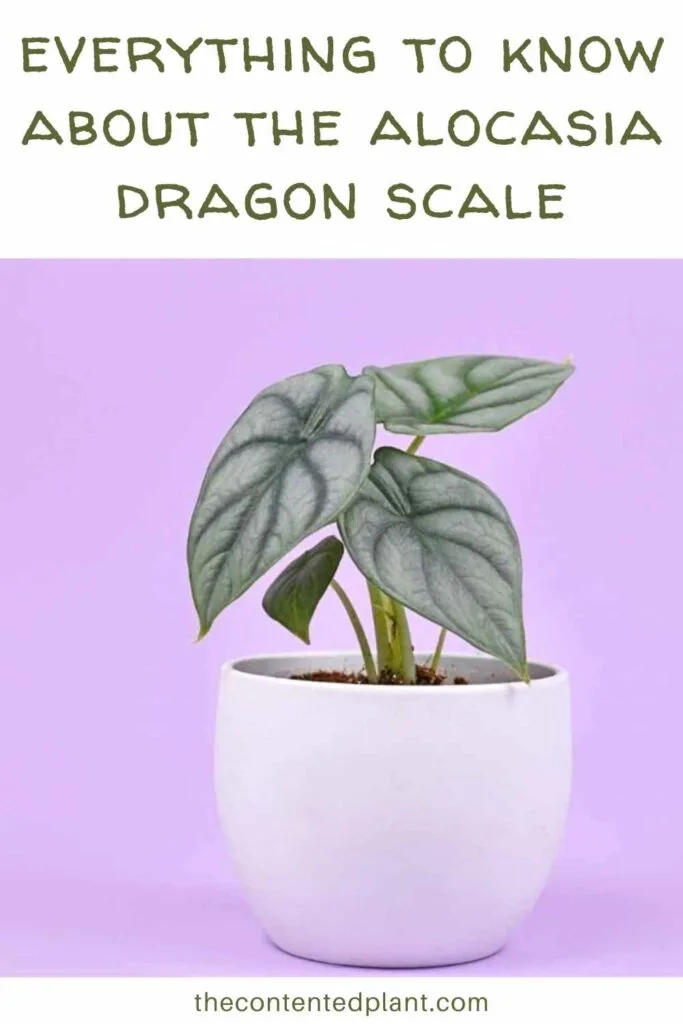

Variegated Burle Marx Plant Care Guide and Profile - The Contented Plant
Tuesday 9th of November 2021
[…] Alocasia dragon scale […]